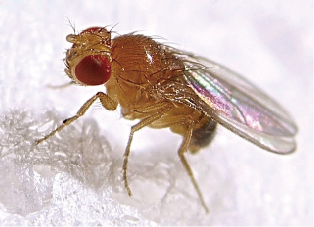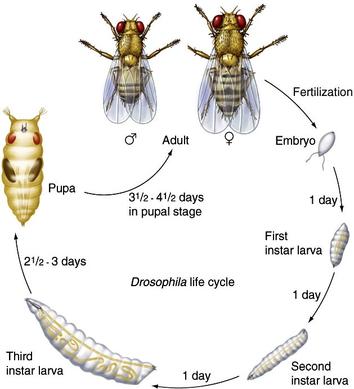Drosophila
Introduction to Drosophila Melanogaster

Drosophila melanogaster is a small, common fly found near unripe and rotted fruit. It has been in use for over a century to study genetics and lends itself well to behavioral studies. Today, several thousand scientists are working on many different aspects of the fruit fly. Thomas Hut Morgan was the preeminent biologist studying drosophila early in the 1900's. Morgan was the first to discover sex-linkage and genetic recombination, which placed the small fly in the forefront of genetic research. Due to its small size, ease of culture and short generation time, geneticists have been using Drosophila ever since. It is one of the few organisms whose entire genome is known and many genes have been identified.
The characteristics of drosophila
- Small and easily handled, well understood.
- Sexually dimorphic, making it is quite easy to differentiate the sexes.
- Entire genome has been sequenced.
- Short generation time (10-12 days), live well at room temperature.
- Easy to culture and keep large numbers, low cost and require little equipment.
The application of drosophila
- Genetic research
- Developmental biology
- Embryonic development research
- Animal behavior
- Neurobiology and genetic disease research
Life cycle of drosophila
D. melanogaster exhibits complete metamorphism, meaning the life cycle includes an egg, larval (worm-like) form, pupa and finally emergence as a flying adult. This is the same as the well-known metamorphosis of butterflies and many other insects. The larval stage has three instars.
Life cycle by day
- Day 0: female lays eggs
- Day 1: eggs hatch
- Day 2: first instar
- Day 3: second instar
- Day 5: Third and final instar
- Day 7: Larvae begin roaming stage. Pupal formation occurs 120h after egg laying.
- Day 11-12: Eclosion. Females become sexually maure 8-10h after eclosion.
The time from egg to adult is temperature dependent. The above cycle is for a range of 21-23 ℃. The higher temperature, the faster generation time, whereas a low (to 18 ℃) temperature causes a longer generation time.
 Figure 1. Life cycle of drosophila.
Figure 1. Life cycle of drosophila.